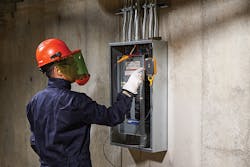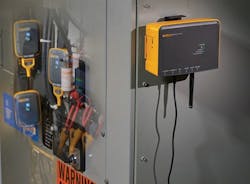Managing machine failure risk with condition monitoring
Technicians, engineers and leaders throughout manufacturing often say their number one maintenance operations challenge is the risk of equipment and device failures. What may be lesser known is that safety risk eclipses downtime cost. For example, mechanical equipment wears out in chemical plants or refineries like anywhere else, but if a valve malfunction creates a gas leak, employees and the entire facility could be at risk.
Yet adopting condition monitoring strategies to mitigate those risks can create new challenges. Among them are: retrofitting costs and feasibility; communication among dispersed workers across plants and regions; security; and safety concerns with adding smart devices in sensitive and explosive environments.
Indeed, in some process industries, project engineers are located at different sites than maintenance and operations. That makes the conversations between technicians, engineers and plant maintenance harder. The more siloed information becomes, the greater the risk that critical issues may not be discovered.
In addition, many plants face difficulty implementing smart devices (tablets, cellphones and laptops) and wireless sensors in their specific environments. Smart devices cannot be allowed in areas with intrinsic safety risks, and the information technology (IT) departments at many plants believe the security concerns about devices on the client network are too great. However, without the benefit of those smart technologies, it is hard for many chemical plants and refineries, for instance, to benefit from maintenance and reliability improvements happening in other industries.
Acknowledging these challenges, how does an operation move from reactive to proactive maintenance? Four strategies are suggested:
- Focus on equipment failure modes — Prioritize plant systems based on the impact on plant capacity and availability. The most expensive equipment does not always have the greatest impact. Think of how second-tier equipment — pumps, compressors, valves, etc. — can impact uptime and, of course, worker safety.
- Get buy-in from leadership — Equipment failures carry risks leaders understand, such as quality issues, lowered overall equipment effectiveness scores and potential unplanned capital expenditures. It is also important to note that many smart technologies have quick returns on investment. For example, a reliability engineer at a chemical processing plant recently noted that his plants include multiple large screw-type compressors ranging from 250 to 2,000 horsepower that support a large refrigeration process. On average, each compressor costs $50,000 new. Currently, compressors are rebuilt every four years at a cost of about $25,000. The reliability engineer explained that if he can extend the rebuild of one motor by one year, he would realize enough savings to nearly pay for the cost of a new vibration analyzer in the first year.
- Select appropriate technologies — Look to infuse available maintenance technologies with wireless capabilities. The idea is to automatically collect data. If creating a proactive, conditionbased maintenance (CBM) program were easy, plants would have implemented programs long ago. The reality is that most plants use a hodgepodge of test tools, various software platforms and sensors. And the controls and assets underpinning older plants are difficult to upgrade. They were never designed to be integrated.The newer test tools have embedded Bluetooth radios that allow the user to instantly save measurements to a software as service (SaaS) platform via a smart device. Portable wireless sensors or modules allow technicians and engineers to leave measurement tools in place up to a month. Once in place, these devices monitor, log data and live-stream.Teams use these sensors for condition monitoring and troubleshooting complex system failures. A cloud-connected software platform underlies both types of datagathering practices so that teams and managers have a comprehensive and meaningfully organized set of data. Dashboards available on any device allow engineers and managers as well as technicians to see actual equipment data to baseline, trend and analyze.
- Enhance skills of team — Increasing the core competencies of the maintenance team can add flexibility to an operation. Many plants create maintenance-specific preventive maintenance (PM) programs in which each department (electrical, mechanical, etc.) has its own specific PM programs and activities that use specific inspection and monitoring technologies such as thermal, vibration and data logging. A centralized reliability team may stay focused on the most mission-critical assets, but the data-gathering practice has "democratized," and with that, the benefits have spread to more areas of the plant. In terms of waves of technology, handheld infrared cameras are typically the first inspection tools teams adopt, but increasingly, vibration meters are a close second for plants with extensive mechanical equipment such as pumps. Vibration inspections detect problems earlier than thermography. As teams grow their PM capabilities, vibration becomes more crucial to their practices.
New practices enabled by technology
All in all, the macrotrend is data. The newer portable condition monitoring systems enable teams to choose which equipment to monitor and what kind of data to collect, with little extra effort, while SaaS PM platforms provide the structure for the data to become meaningful enough to drive decisions and actions.
Ideally, teams would use smart devices for all aspects of data gathering, from wired sensors to wireless sensors to connected test tools. That way the data is automatically tagged, saved and trended. While wired sensors have been the go-to, the enterprise systems associated with them do not always lend themselves to straightforward route management, work orders and other workflow aspects central to integration. SaaS PM systems, with mobile devices and wireless sensors as core components, are increasingly the best ways for teams to integrate their data and workflows.
Having the right data to detect a change in the condition of a piece of equipment is tremendously valuable. Teams can prioritize their workload to avoid failures and unnecessary planned maintenance. Integrated data streams — for example, power monitoring plus thermal images or vibration followed by thermal — dramatically speed up decision-making. The alarm features on SaaS PM systems alert the teams to changes in conditions while mobile workflow tools make it possible for teams to move into action. Web-based SaaS platforms allow data sharing with everyone on a team as well as between departments and between teams and their management.
Portable wireless sensors allow technicians and engineers to leave measurement tools in place up to a month. Once in place, these devices monitor, log data and live-stream.
Explore "safe zones"
Finally, for highly regulated intrinsic safety environments, one alternative to current practices being explored is the establishment of "safe zones" where low-energy smart devices can be deployed in nonexplosive Category 2 areas. Out on the plant floor, technicians would use approved tools to collect data and then use the safe zone area to connect the tool to the SaaS platform and complete the upload.
Many sites are also installing secondary wireless networks, specifically for wireless Industrial Internet of Things (IIoT) devices. These secondary guest networks introduce an extra security layer, protecting core plant assets while giving the IIoT devices the Wi-Fi connectivity they need to collect and send data.
As an end goal, the idea is to enable new simplified workflows with which data collection is easier, the data itself is reliable and the PM routing is flexible, depending on team priorities. With a common platform to store data — one that is easily accessible — operators can begin to analyze and correlate data from various technologies. For example, checking time-stamped vibration spectra and infrared data with current trend lines can give insight into equipment health. These data can help foretell impending failures. These newer CBM systems offer solutions without retrofitting, specialized labor or IT resources. And since such systems exist outside control networks, they do not put operations at risk. Beyond the data, the same software can be used to issue work orders, track work completion and even verify the service is completed correctly.
Frederic Baudart is a product application specialist for Fluke Corporation, focusing on the company’s process, electrical and mechanical product lines. He has 20 years of experience in field service engineering work and the preventive maintenance industry. He has held various field services and technical positions with responsibility for installation and commissioning as well as services management roles. Baudart is Thermal/Infrared Thermography Level I certified and holds technical degrees in electrical and instrumentation engineering from Chome-Wynz technical college in Brussels, Belgium. Learn more at connect.fluke.com.


